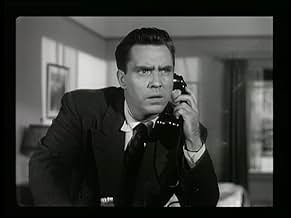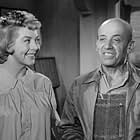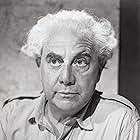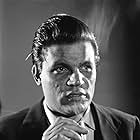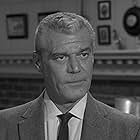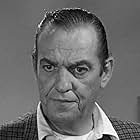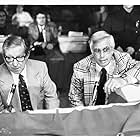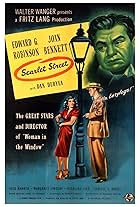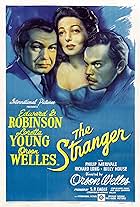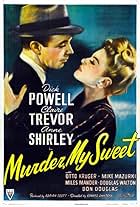Frank Bigelow, told he's been poisoned and has only a few days to live, tries to find out who killed him and why.Frank Bigelow, told he's been poisoned and has only a few days to live, tries to find out who killed him and why.Frank Bigelow, told he's been poisoned and has only a few days to live, tries to find out who killed him and why.
- Awards
- 1 win
Beverly Garland
- Miss Foster
- (as Beverly Campbell)
Cay Forester
- Sue
- (as Cay Forrester)
Frank Jaquet
- Dr. Matson
- (as Fred Jaquet)
Lawrence Dobkin
- Dr. Schaefer
- (as Larry Dobkin)
Bill Baldwin
- St. Francis Hotel Desk Clerk
- (uncredited)
Storyline
Did you know
- TriviaThe scene in which Bigelow runs in panic through the streets after learning he has been poisoned was what is considered a 'stolen shot' where the pedestrians along the sidewalk had no idea a movie was being made and no warning that Edmond O'Brien would be plowing through them.
- GoofsAfter finding out who's in the photo, Bigelow leaves the photography studio and immediately starts getting shot at. He heads toward the factory (screen right) where the shots are supposed to be coming from, but all the shots being fired and ricocheting off the ground, pipe, barrel, etc. are coming from the other direction (screen left).
- Quotes
[first lines]
Homicide Detective: Can I help you?
Frank Bigelow: I'd like to see the man in charge.
Homicide Detective: In here...
Frank Bigelow: I want to report a murder.
Homicide Captain: Sit down. Where was this murder committed?
Frank Bigelow: San Francisco, last night.
Homicide Captain: Who was murdered?
Frank Bigelow: I was.
- Crazy creditsThe end credits read "The medical facts in this motion picture are authentic. Luminous toxin is a descriptive term for an actual poison. Technical Adviser, Edward F. Dunne, M.D."
- Alternate versionsAlso available in a colorized version.
- ConnectionsEdited into Déjà-vu (2000)
Featured review
I hate formal film evaluation lists that ostentatiously rate the relative value of certain films, such as Citizen Kane for example. I do think Citizen Kane is a great film. But I also think that about fifteen or twenty other films I could quickly name are every bit as good as Kane in their own way. (Almost any Richard Gere movie, for example. Just kidding.)
This brings me to D.O.A., directed by Rudolf Maté. D.O.A. in my book is the Citizen Kane of the noirs. It's so good that I often wonder about how it got made in the first place. Since many of the people who were involved in its production are now no longer with us, I may never learn anything about its origins. That's a frustration, of course, but the more important thing is that I can recognize a great noir when I see it.
Why, you ask, is D.O.A. a great noir? The most obvious reason is its plot. A guy goes out for a night on the town and someone, a total stranger, slips him a mickey in a bar-a lethal mickey. But it doesn't kill him instantly. It kills him slowly, so slowly that he's given the chance to find out who did this terrible thing to him, and why.
Second, the film is exceptionally well made in every other respect. Okay, the Pamela Britton character is one dimensional and embarrassing, we all agree on that, but who really cares when everything else in the film is so good? Edmond O'Brien had one of the best roles of his career in D.O.A., and he took full advantage, though few critics give his performance much credit for the film's success.
O'Brien, a classically trained actor, plays a small-time Southern California businessman living his ordinary little life, minding his own business, regularly boffing his secretary (this was implied rather than made explicit; after all, this was 1949), and avoiding her whiney entreaties that they tie the knot, as he's been promising her he would do for ever so long.
You can't help liking O'Brien in part precisely because of his human flaws. He's basically decent, but harassed, overworked, and stretched to the limit by the pressure put on him by Britton. What adult male couldn't identify with this man, or at least sympathize? His very insignificance as one more human ant on the planet Earth, and the terrible thing that's about to happen to him, are the essence of great film noir. (Detour, although by no means a favorite noir of mine, is nevertheless another perfect example of an ordinary man, a small-timer, minding his own business and unexpectedly colliding with Fate and all that it has in store for him.) We resonate to D.O.A. because fate and contingency have been the fundamental conditions of life on the planet earth since before the beginning of history. Our time on Earth is brief and our lives but little scraps of paper blown about by the wind toward endings we know not. We live noir lives.
The film's particulars are wonderful. From the sunny hick town of Banning, the movie switches quickly to San Francisco. If ever there were a noir town, it's Frisco. (Hitchcock picked up on that real quick; watch Vertigo again to see how he saw the eerie side to that town, with its creepy deserted streets, little ghostlike fog-blown urban hills, and other abandoned places suggestive of loneliness and soullessness.)
From here one great noir scene follows another in astonishing succession: the smoky, crowded jazz bar where the sweaty black musicians are blowing up a storm (to an all-white 1949 audience of course), while a murder is silently committed with a switched drink. The doctor holding the eerily glowing glass tube of luminescent poison and informing O'Brien, "You've been murdered." O'Brien running through the crowded downtown streets like a madman, as if velocity could help him escape his fate. O'Brien, after being shot at, a gun now in his own hand, looking for his killer in the abandoned processing plant. His encounter with Luther Adler's insane, sadistic henchman played by Neville Brand. Brand, speaking softly, glints of spittle in the corners of his mouth, nutty little eyes lighting up with anticipated pleasure: "I'm gonna give it to you in the belly. You're soft in the belly, aren't'cha? " Then the fantastic night scene in the crowded Los Angeles drugstore with Brand stalking him among oblivious customers-till shots ring out, then screams, followed by death. Finally, again at night, O'Brien's confrontation with his killer, which (inevitably) occurs in the Bradbury Building, that great architectural shrine to noir, scene of so many other noir films.
Let's stop for a moment and go back to an earlier part of the film. Fatally poisoned, still not quite believing what has happened to him, exhausted and uncertain of anything, O'Brien has run for block after block, but now his energy has finally petered out and he finds himself alone near the docks. Utterly depleted, all hope lost, he wearily leans against the side of an old wooden newsstand in an otherwise bleak, abandoned area. Eyes glazing over, he's terrified, trying to catch his breath. During a medium close-up we briefly study him, then notice something to his left, a single long vertical row of magazines, all identical covers, arranged down the side of the kiosk just half a hand away from him. He isn't looking at them, isn't really aware of them, but we are. For just a few seconds we see: Life, Life, Life, Life, Life, Life, Life. Then the film quickly moves on and goes about its business, as if we had been shown nothing of importance.
You tell me this isn't a great film noir.
This brings me to D.O.A., directed by Rudolf Maté. D.O.A. in my book is the Citizen Kane of the noirs. It's so good that I often wonder about how it got made in the first place. Since many of the people who were involved in its production are now no longer with us, I may never learn anything about its origins. That's a frustration, of course, but the more important thing is that I can recognize a great noir when I see it.
Why, you ask, is D.O.A. a great noir? The most obvious reason is its plot. A guy goes out for a night on the town and someone, a total stranger, slips him a mickey in a bar-a lethal mickey. But it doesn't kill him instantly. It kills him slowly, so slowly that he's given the chance to find out who did this terrible thing to him, and why.
Second, the film is exceptionally well made in every other respect. Okay, the Pamela Britton character is one dimensional and embarrassing, we all agree on that, but who really cares when everything else in the film is so good? Edmond O'Brien had one of the best roles of his career in D.O.A., and he took full advantage, though few critics give his performance much credit for the film's success.
O'Brien, a classically trained actor, plays a small-time Southern California businessman living his ordinary little life, minding his own business, regularly boffing his secretary (this was implied rather than made explicit; after all, this was 1949), and avoiding her whiney entreaties that they tie the knot, as he's been promising her he would do for ever so long.
You can't help liking O'Brien in part precisely because of his human flaws. He's basically decent, but harassed, overworked, and stretched to the limit by the pressure put on him by Britton. What adult male couldn't identify with this man, or at least sympathize? His very insignificance as one more human ant on the planet Earth, and the terrible thing that's about to happen to him, are the essence of great film noir. (Detour, although by no means a favorite noir of mine, is nevertheless another perfect example of an ordinary man, a small-timer, minding his own business and unexpectedly colliding with Fate and all that it has in store for him.) We resonate to D.O.A. because fate and contingency have been the fundamental conditions of life on the planet earth since before the beginning of history. Our time on Earth is brief and our lives but little scraps of paper blown about by the wind toward endings we know not. We live noir lives.
The film's particulars are wonderful. From the sunny hick town of Banning, the movie switches quickly to San Francisco. If ever there were a noir town, it's Frisco. (Hitchcock picked up on that real quick; watch Vertigo again to see how he saw the eerie side to that town, with its creepy deserted streets, little ghostlike fog-blown urban hills, and other abandoned places suggestive of loneliness and soullessness.)
From here one great noir scene follows another in astonishing succession: the smoky, crowded jazz bar where the sweaty black musicians are blowing up a storm (to an all-white 1949 audience of course), while a murder is silently committed with a switched drink. The doctor holding the eerily glowing glass tube of luminescent poison and informing O'Brien, "You've been murdered." O'Brien running through the crowded downtown streets like a madman, as if velocity could help him escape his fate. O'Brien, after being shot at, a gun now in his own hand, looking for his killer in the abandoned processing plant. His encounter with Luther Adler's insane, sadistic henchman played by Neville Brand. Brand, speaking softly, glints of spittle in the corners of his mouth, nutty little eyes lighting up with anticipated pleasure: "I'm gonna give it to you in the belly. You're soft in the belly, aren't'cha? " Then the fantastic night scene in the crowded Los Angeles drugstore with Brand stalking him among oblivious customers-till shots ring out, then screams, followed by death. Finally, again at night, O'Brien's confrontation with his killer, which (inevitably) occurs in the Bradbury Building, that great architectural shrine to noir, scene of so many other noir films.
Let's stop for a moment and go back to an earlier part of the film. Fatally poisoned, still not quite believing what has happened to him, exhausted and uncertain of anything, O'Brien has run for block after block, but now his energy has finally petered out and he finds himself alone near the docks. Utterly depleted, all hope lost, he wearily leans against the side of an old wooden newsstand in an otherwise bleak, abandoned area. Eyes glazing over, he's terrified, trying to catch his breath. During a medium close-up we briefly study him, then notice something to his left, a single long vertical row of magazines, all identical covers, arranged down the side of the kiosk just half a hand away from him. He isn't looking at them, isn't really aware of them, but we are. For just a few seconds we see: Life, Life, Life, Life, Life, Life, Life. Then the film quickly moves on and goes about its business, as if we had been shown nothing of importance.
You tell me this isn't a great film noir.
- burgbob975
- May 26, 2002
- Permalink
Details
- Release date
- Country of origin
- Official sites
- Language
- Also known as
- Dead on Arrival
- Filming locations
- Justin Herman Plaza, San Francisco, California, USA(current site of 'The Fisherman')
- Production companies
- See more company credits at IMDbPro
- Runtime1 hour 23 minutes
- Color
- Aspect ratio
- 1.37 : 1
Contribute to this page
Suggest an edit or add missing content









